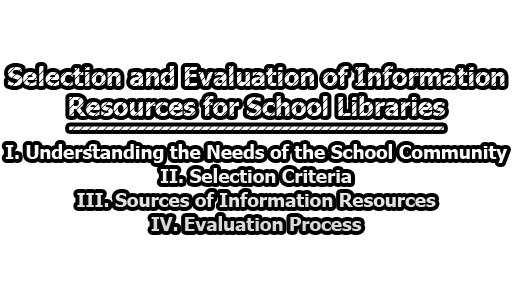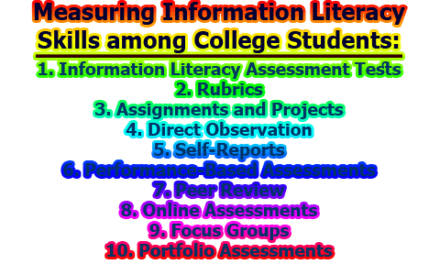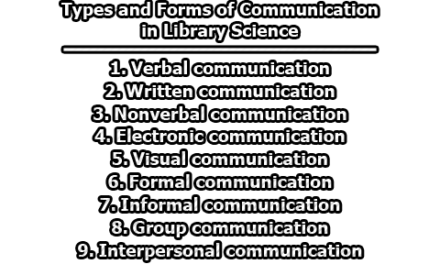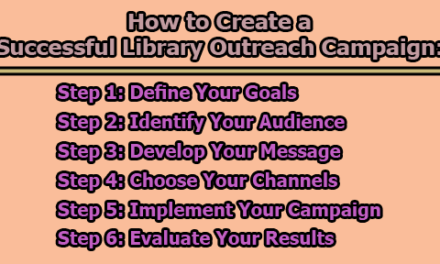Selection and Evaluation of Information Resources for School Libraries:
In the digital age, school libraries play a vital role in providing students with access to a wide range of information resources. The selection and evaluation of information resources are crucial tasks for school librarians to ensure that students have access to reliable, relevant, and up-to-date information. In the rest of this article, we are going to know about the process of the selection and evaluation of information resources for school libraries, focusing on key considerations, criteria, and best practices.
II. Understanding the Needs of the School Community:
Before embarking on the selection process, it is essential to understand the specific needs and requirements of the school community. This involves considering the grade levels, curriculum, and educational goals of the school. School librarians should collaborate with teachers, administrators, and students to identify the subject areas and topics that require the most attention. By understanding the needs of the school community, librarians can make informed decisions about the types of resources that will best support the learning objectives of the students.
II. Selection Criteria:
When selecting information resources, several criteria should be taken into account to ensure their suitability and quality. These criteria may include:
- Authority and Credibility:
- Resources should be authored by experts in their respective fields and published by reputable sources.
- Information from government agencies, academic institutions, and renowned publishers tends to be reliable and accurate.
- Relevance and Appropriateness:
- Resources should align with the curriculum, instructional goals, and the age appropriateness of the intended audience.
- Materials that reflect diverse perspectives and experiences should be considered to promote inclusivity and cultural awareness.
- Accuracy and Currency:
- Information resources should be factually accurate, up-to-date, and reflect the latest research and developments in the field.
- Outdated or inaccurate resources may mislead students and hinder their learning.
- Accessibility and Usability:
- Resources should be easily accessible and user-friendly, both physically and digitally.
- Printed materials should be organized effectively, with clear labeling and appropriate cataloging systems.
- Digital resources should be compatible with various devices and provide clear navigation.
- Diversity and Representation:
- It is crucial to ensure that the collection of resources reflects the diverse backgrounds, cultures, and experiences of the student body.
- Including resources that cater to different learning styles, abilities, and interests will create an inclusive and engaging learning environment.
- Cost and Budget:
- Considering the available budget is essential when selecting information resources.
- Librarians should seek cost-effective options and prioritize resources that offer the best value for money.
- Collaborating with teachers and administrators to identify funding sources and potential partnerships can help expand the library’s collection.
III. Sources of Information Resources:
There are various sources of information resources that school librarians can explore during the selection process. These sources include:
- Books and Print Materials:
- Traditional print books continue to be a valuable resource in school libraries.
- They provide in-depth information, support critical thinking, and foster a love for reading.
- Librarians should consider both fiction and non-fiction books, ensuring a diverse collection that covers a wide range of topics and genres.
- Collaboration with teachers to identify recommended texts and popular authors can help guide the selection process.
- Digital Resources:
- In today’s digital age, digital resources have become increasingly important.
- These resources include e-books, databases, online encyclopedias, educational websites, multimedia materials, and e-journals.
- School librarians should evaluate the credibility, accessibility, and functionality of digital resources before incorporating them into the library’s collection.
- Collaborating with IT departments and seeking input from students and teachers on their preferred digital platforms can inform the selection process.
- Periodicals and Magazines:
- Periodicals and magazines offer current information on a wide range of topics.
- They can provide students with up-to-date news, research findings, and real-world examples.
- Librarians should select periodicals and magazines that are reputable, age-appropriate, and align with the school’s curriculum.
- Considering subscriptions to both physical and digital periodicals can provide a well-rounded collection.
- Audiovisual Materials:
- Audiovisual materials, such as educational videos, documentaries, and multimedia resources, can enhance students’ understanding and engagement with various subjects.
- Librarians should consider the educational value, accuracy, and relevance of audiovisual materials before integrating them into the library’s collection.
- Collaboration with media specialists and educators can help identify relevant audiovisual resources and ensure alignment with instructional goals.
IV. Evaluation Process:
The evaluation process is a critical step in ensuring that information resources meet the selection criteria and provide high-quality content. Here are some steps to consider during the evaluation process:
- Reviewing the Source:
- Examine the reputation and credibility of the author, publisher, or organization responsible for producing the resource.
- Check if the content aligns with recognized standards or guidelines in the field.
- Verify the author’s credentials, expertise, and affiliations.
- Assessing the Content:
- Evaluate the accuracy, comprehensiveness, and objectivity of the resource.
- Look for evidence of thorough research, references, and citations to support the claims made in the material.
- Determine if the content presents multiple perspectives or biases and consider how it may affect students’ understanding of the subject matter.
- Considering the Audience:
- Determine if the resource is suitable for the intended audience, taking into account the reading level, language, and cultural sensitivity.
- Ensure that the material supports diverse learning styles and abilities.
- Consider whether the resource provides opportunities for critical thinking, analysis, and reflection.
- Checking Currency and Relevance:
- Verify the currency of the information presented in the resource.
- Identify whether the content is up-to-date and reflects current research and understanding in the field.
- Assess the relevance of the resource to the curriculum and educational goals.
- Consider if the resource addresses contemporary issues and promotes global awareness.
- Seeking Reviews and Recommendations:
- Consult professional reviews, recommendations from reputable sources, and feedback from educators who have used the resource.
- Their insights can provide valuable guidance and help make informed decisions.
- Engage in professional networks and attend conferences or workshops to learn about new resources and best practices in the field.
It is apparent that the selection and evaluation of information resources for school libraries require careful consideration of the needs of the school community, adherence to selection criteria, and a comprehensive evaluation process. By following these best practices, school librarians can build collections that support students’ educational goals, foster critical thinking skills, and promote lifelong learning. A well-curated library collection enhances the learning experience and equips students with the skills they need to navigate the information landscape effectively. Continuous evaluation and adaptation of the library’s collection based on feedback and changing needs ensure that students have access to relevant, accurate, and diverse information resources.
FAQs:
How can school librarians understand the needs of the school community?
School librarians can understand the needs of the school community by collaborating with teachers, administrators, and students. They can hold meetings, surveys, and focus groups to gather input on the subject areas, topics, and resources that are most relevant to the curriculum and educational goals of the school. Additionally, they can review curriculum documents, attend faculty meetings, and stay updated on educational trends to gain insights into the specific needs of the school community.
Why is it important to consider the authority and credibility of information resources?
Considering the authority and credibility of information resources is crucial to ensure that students have access to reliable and accurate information. Resources authored by experts in their respective fields and published by reputable sources are more likely to provide trustworthy and well-researched content. By evaluating the authority and credibility of information resources, school librarians can guide students toward high-quality sources and promote critical thinking and discernment when it comes to accessing information.
How can school librarians ensure the accessibility and usability of information resources?
School librarians can ensure the accessibility and usability of information resources by organizing printed materials effectively, implementing clear labeling systems, and using appropriate cataloging techniques. They should also consider the physical arrangement of resources to make them easily accessible to students of different ages and abilities. In the case of digital resources, librarians should select platforms and interfaces that are user-friendly, compatible with various devices, and offer clear navigation options to facilitate easy access and utilization.
What role does diversity and representation play in the selection of information resources?
Diversity and representation play a crucial role in the selection of information resources as they promote inclusivity, cultural awareness, and a broader understanding of different perspectives. School librarians should strive to include resources that reflect the diverse backgrounds, cultures, and experiences of the student body. This can include resources authored by diverse authors, covering a wide range of topics, and representing various cultures, ethnicities, genders, and abilities. By incorporating diverse resources, librarians can create an inclusive and enriching learning environment that respects and celebrates differences.
How can school librarians evaluate the relevance of information resources to the curriculum?
School librarians can evaluate the relevance of information resources to the curriculum by examining how well the content aligns with the learning objectives and subject areas outlined in the curriculum. They can review the resource’s table of contents, summaries, or abstracts to assess if it covers the desired topics and concepts. Additionally, librarians can consult with teachers and subject matter experts to seek their input on the relevance of specific resources to the curriculum. Regular communication and collaboration with educators can help ensure that the library’s collection remains aligned with the curriculum and supports instructional goals.
How can librarians keep their information resources up-to-date?
Librarians can keep their information resources up-to-date by regularly reviewing and replacing outdated materials. They should stay informed about the latest research, developments, and trends in various subject areas and actively seek out new editions or updated versions of resources. Subscribing to relevant journals, attending professional development workshops, and participating in professional networks can provide librarians with the latest information and insights into newly published materials. Librarians can also encourage teachers, students, and other library users to provide suggestions for new resources or notify them of any outdated materials they come across.
What role do reviews and recommendations play in the evaluation process?
Reviews and recommendations play a valuable role in the evaluation process as they provide insights and feedback from experts and educators who have already utilized the resources. Librarians can consult professional reviews from reputable sources such as library journals, educational websites, or subject-specific associations. They can also seek recommendations from colleagues, attend conferences or workshops, and participate in online communities to gather feedback and insights from experienced professionals. Reviews and recommendations can offer valuable perspectives on the content, quality, and instructional value of information resources, helping librarians make informed decisions during the evaluation process.
References:
- American Association of School Librarians. (2018). National School Library Standards for Learners, School Librarians, and School Libraries. American Library Association.
- Branch, J. L., Gilchrist, D. J., & Herring, J. E. (2015). The school library as a digital learning space. In M. J. Knapp, C. E. Melton, & H. J. DeGroff (Eds.), School librarianship: Past, present, and future (pp. 157-186). Scarecrow Press.
- Lamb, A., & Johnson, L. (2017). Selecting and evaluating resources. In L. Johnson (Ed.), School libraries transformed: 50 years of the school library journal (pp. 155-162). ABC-CLIO.
- Latham, D., Gross, M., & Burtis, J. (2019). Collection development for digital libraries: An evaluation of current practices and emerging trends. Journal of Librarianship and Information Science, 51(4), 973-990.
- Loertscher, D. V., & Koechlin, C. (2019). The new school library learning commons: Where learners win! Libraries Unlimited.
- Maatta, S. L. (2017). The changing role of the school library in the digital age: Issues and challenges. In C. N. Pope & P. D. Mardis (Eds.), School librarianship: Past, present, and future (pp. 123-134). Libraries Unlimited.
- Purcell, M., Rainie, L., Heaps, A., Buchanan, J., Friedrich, L., Jacklin, A., & Chen, C. (2012). How teens do research in the digital world. Pew Research Center.
- Todd, R. J. (2017). Evidence-based practice: Towards a research agenda for school librarianship and teacher librarians. School Libraries Worldwide, 23(1), 1-14.
- Valenza, J. K. (2010). Manifesto for 21st-century school librarians. School Library Journal, 56(11), 32-34.
- Valenza, J. K. (2015). Curate, evaluate, create: A framework for understanding information literacy. School Library Monthly, 31(1), 20-23.
- Valenza, J. K., & Stephens, W. (2012). Jump-start your research: A guide for students and teachers. Libraries Unlimited.

Library Lecturer at Nurul Amin Degree College










